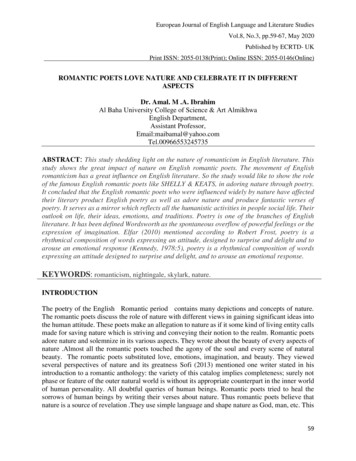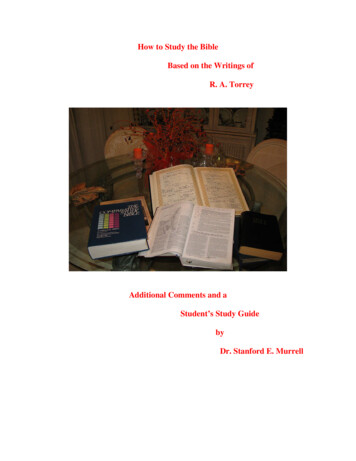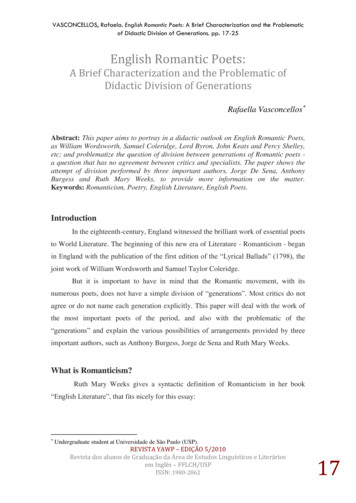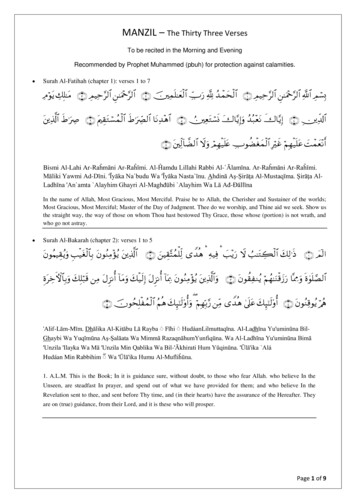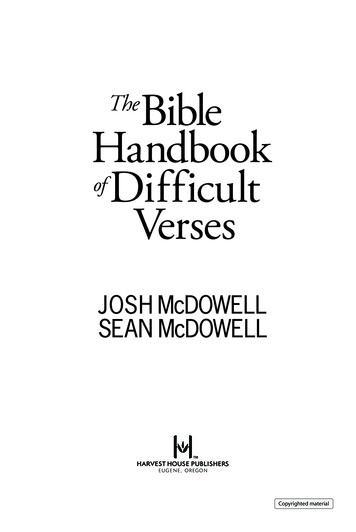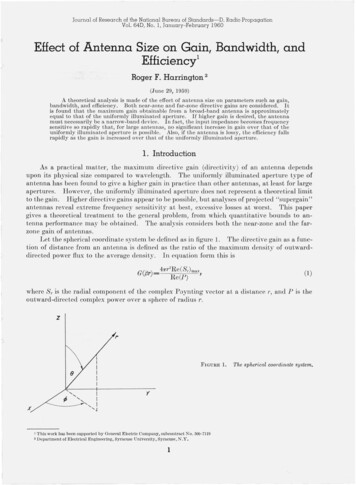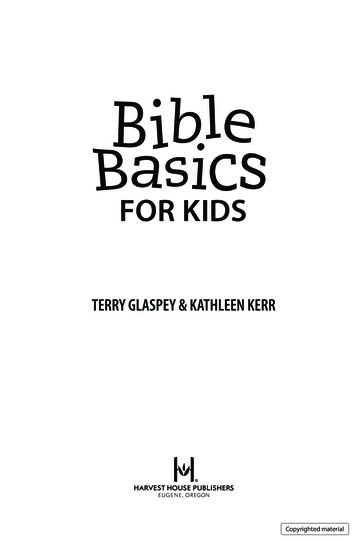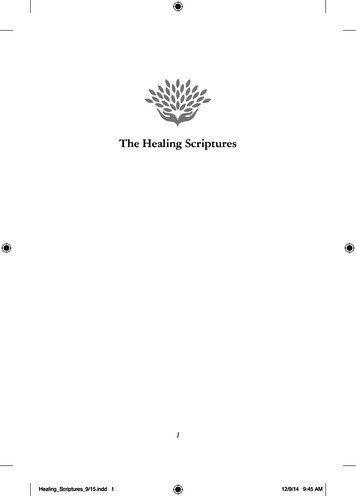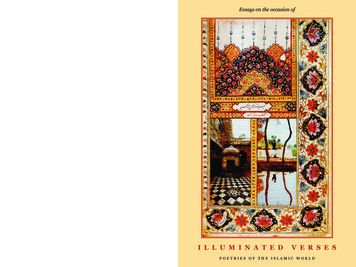
Transcription
Essays on the occasion ofwww.citylore.orgwww.poetshouse.orgI L L U M I N A T E DV E R S E SPOETRIES OF THE ISLAMIC WORLD
ty
Essays on the occasion ofI l l u m i n a t e dV e r s e sPoetries of the Islamic World
Edited by C a t h e r i n e F l e t c h e rCover artwork by S a m i n a Q u r a e s h iBooklet design by HR H e g n a u e r 2011 City Lore and Poets House
TA B LE O F C ONTENTS1Lee BriccettiI L L U M I N A T E D V E R S E S : P OETR I ES O F THE I SLAM I C W ORLD4Steve ZeitlinP ATH W AYS TO I L L U M I N A T E D V E R S E S7Persis KarimMY F ATHER ’ S HOUSE10Kazim AliTHE ROSE I S MY Q I B L A : SOHRA B SE P EHR I ’ S J OURNEY EAST17Mahwash ShoaibLAHORE I N LYR I C S23Najwa AdraS I NG I NG THE I R M I NDS28Steve CatonYEMEN ’ S G I F TS32Ammiel AlcalayA P LA C E F OR P OETRY35Reza AslanL I TERATURE ’ S RE V OLUT I ONS39GLOSSARY42NOTES ON TRANSLAT I ONS43ESSAY I STS ’ B I OGRA P H I ES45I L L U M I N A T E D V E R S E S E V ENTS47A B OUT I L L U M I N A T E D V E R S E S48F UNDERS
Lee BriccettiExecutive Director, Poets HouseILLUMINATED VERSES:P OETR I ES O F THE I SLAM I C W ORLDA window for seeing.A window for hearing.A window like a wellthat plunges to the heart of the earth.—Forugh Farrokhzad, “Window” 1The discussions and readings of Illuminated Verses bring together poets,scholars, performers, and poetries from around the Islamic world—as awindow for seeing and hearing, as a well to the heart of our humanity.Poetry is one of the most beloved art forms in the Islamic world. Butto say so is a generalization, since there is no single Islamic world. Poetry,too, is multiple.So, rather, we say: welcome. Welcome to this special conference andcelebration, as we explore poetries from diverse cultures and languages,and experience the art’s many pleasures.The Illuminated Verses panel discussions and evening performances, presented on May 7, 2011 at the Borough of Manhattan CommunityCollege, cannot be comprehensive. Nonetheless, they are abundant; fromevents focused on centuries-old verse traditions of Sufi and Golden AgeArabic poets to discussions of modernist and contemporary practitioners.They were preceded by events that contextualized this conference—anopen seminar on the Qur’an; an overview of the literary histories ofIslam; and evenings on poetries from Persia, Pakistan, West Africa, andMorocco. Yet, this can only be a beginning.L e e B r icc e t t i 1
Vilification of Islam in our national dialogue, particularly over the lastdecade, has compounded age-old Western stereotypes and re-emphasizeddivisions. Many ossified preconceptions—some from the Middle Ages—have rendered Islamic literatures almost unknown to us. But thankfully,a new generation of translators and anthologists has begun to open thiswork to new audiences, inviting general readers—as Whitman bade us—to sift for ourselves.In some sense, Illuminated Verses is also Illuminated Voices. Whilewriting expands thinking immeasurably, allowing for memory beyondthe single mind, orality and the spoken word live in our writing. Thisis particularly true in poetry, as the breath of the poet’s voice creates apalpable music in a world of sound. Illuminated Verses makes a pointof foregrounding the exchanges between oral formulas and writtentexts, which have characterized many literatures throughout theIslamic world.While all serious writers engage in a dialogue with the oral and literarytraditions that have shaped them, as members of a non-specialist audienceapproaching these literatures for the first time, we may not be aware ofall of the rich nuances they carry. Yet wider community engagement inrespectful listening will inevitably lead us to make new discoveries.We know that there are complexities in these discussions—somehaving to do with what we bring to our own listening; some on the page,connected to translation; others geographical and political. Last fall, whenPoets House hosted Urdu poet Afzal Ahmend Syed—or rather, publiclyteleconferenced with him because he was denied a visa—we were movedby the wry dissent of his work. “If my voice is not reaching you / add to itthe echo— / echo of ancient epics ,”2he writes.Though, ultimately, his voice reached us, it was not easy to enterinto our exchange given the enforced geographic distance. We alsoencountered a basic paradox in Syed’s work that has been presentthroughout this series: not all the scholars and writers assembled in thesepages, or at these events, identify themselves as “Islamic” writers even ifthey are consciously working in relationship to Islamic traditions.2 illuminated verses
Illuminated Verses is supported by a special grant from the BridgingCultures Initiative of the National Endowment for the Humanities. Weare especially grateful for their commitment to generative conversationas a force in a strong democracy. We thank all presenters, essayistsand the many advisors who provided ideas and assisted with planningsessions: among them, Najwa Adra, Ammiel Alcalay, Kazim Ali, SteveCaton, Pierre Joris, and Khalad Mattawa.Poets House is delighted to have co-organized this remarkableconvening with City Lore, the organization with which we producedmany joyous People’s Poetry Gatherings. And we acknowledge thesignificant partnership of the Asia Society and the Borough of ManhattanCommunity College.Newly settled into our permanent home at 10 River Terrace, justblocks away from the Borough of Manhattan Community College campuswhere the conference is being held, Poets House is a 50,000-volumepoetry library that invites everyone into the living traditions of poetry.Illuminated Verses is emblematic of the work Poets House loves to do.We host hundreds of events each year documenting poetic practices fromaround the globe, as we make a place for poetry in our cultural landscapeand in individual lives, one by one.Poets House’s co-founder, Stanley Kunitz wrote that poetry is history’smost enduring recording device, telling us what it feels like to be alive in acertain time and place. We hope that these programs will initiate ongoingdialogue, expanding our pleasure in these literatures, which are so rich apart of our shared human legacy.You are this passage being deciphered,born in each interpretation —Adonis, “The Beginning of the Book” 3L e e B r icc e t t i 3
Steve ZeitlinExecutive Director, City LoreP ATH W AYS TO I L L U M I N A T E D V E R S E SIn 2003, as part of City Lore’s Poetry Dialogues, workshop co-leaderBushra Rehman sought to engage one of the students, Mugeeb, with afree verse poem. He complained, “All the American poetry I see, it’s notlike Arabic poetry. It doesn’t rhyme. It doesn’t have a—” he paused,unable to think of the word.“A form?”“Yeah. A form. How do you know if something is a poem?” He seemedfrustrated,” Bushra observed, “and I could tell that this was somethingthat he had been struggling with.” Bushra pointed out that some of ourpoetry, like sonnets and blues poetry, does have a prescribed form, butMugeeb wasn’t convinced. Then she pointed at a picture of Walt Whitmanon the wall and said, “It’s all his fault.”As she described in her essay, “Recite! Teaching Poetry to MuslimAmerican Youth and Allies in NYC,” “American poetry is like Americanculture. Our lack of tradition is our tradition. The students laughed,” shewrote, “but I knew that Mugeeb’s question was not just about poetry,it was about understanding American culture where all the rules weremissing.”As City Lore and Poets House began to plan Illuminated Verses,we sought to convey the diversity of Islamic cultures and poetry (Manywriters from the Middle East and South Asia, for instance, do write in freeverse.) Our goal was to render Islamic cultures more accessible to U.S.audiences by highlighting poetry, which is to much of the Islamic worldwhat movies or pop music are to American culture.With that in mind, we decided to ask some of the participants in ourprogram to write about what first inspired them about Islamic poetry. Italso motivated me to reflect on what inspired City Lore to join forces withPoets House for this endeavor.4 illuminated verses
I realized that what inspired us began right here in New York.Exploring the cultures that comprise the city, we were also discoveringthe poetries of the Islamic world. We were struck by the devotion ofthe Muslim communities to their poetry traditions and their desire tohave other New Yorkers share in them. At our 1999 Poetry Gathering,crowds lined up around the block, fighting for tickets for a sold-outshow, “Drunken Love,” with Iranian singer Sharam Nazeri singing thework of the Persian classical poet and mystic Rumi. In 2004, we held amushaira Poetry Dinner at Shaheen’s Sweets in Jackson Heights. Eachof the local Pakistani poets contributed one ghazal for the program. Acollege professor in the group provided a literal translation of each poem.The translation was read as well as the ghazal in the original languageat the event. In addition, poet Bob Holman worked with the poets tocreate a more free-flowing and poetic English-language version of thepoem which he performed. As is the custom at a mushaira, when thepoet reads a line that the audience likes, the audience responds with a“wawa,” and the poet repeats the line with even greater emphasis. Formost of the poems, the original versions were met with multiple “wawas,”the literal English translations with only a few. The freewheeling andpoetic English translations and performances by Holman were met witha shower of “wawas,” to the delight of the participating poets.Among the inspirations for this program, too, was anthropologistSteven Caton’s book, ‘Peaks of Yemen I Summon’, which illustrates howforms such as the zamil—a rhyming two-line poem—can be used fornegotiation in tribal cultures, how improvised forms like the balah—composed as a duel by two or more poets—are performed at weddingsand how longer poems circulate throughout Yemen on cassettes. I wasstruck by the centrality of poetry in this Islamic culture. Abu Dhabitelevision, I learned, broadcasts a kind of American Idol for poetry! Andpoetry and song were central to the recent Egyptian revolution. (In thesong “Sout al-Horeya,” by Eid Amir and Many Adel, posted on YouTube,“Our dreams were our weapon we write our history with our blood.”)Steve zeitlin 5
In the same way that American movies and popular culture havecreated a pathway to understanding the U.S. for those abroad, heighteningawareness of an art form central to many Muslim cultures can betterenable Americans to relate to those cultures. We hope that creating anappreciation for an art form central to many Islamic cultures in this timeof turmoil may help build some bridges and heal some wounds.The potential of poetry to create indelible images, to extend thereach of language, and to express complex ideas and feelings throughmetaphor makes it a powerful force for illuminating cultural experiences.Characterized by the intensification of language, poetry is an ideal formfor artfully expressing individual and collective identities. As culturesclash over religion, Illuminated Verses: Poetries from the Islamic Worldinvites disparate cultures to see one another anew.The planning for Illuminated Verses reminded me of a line fromRumi, translated by Coleman Barks:There is some kiss we want withour whole lives, the touch ofspirit on the body. Seawaterbegs the pearl to break its shell.Poetry, ubiquitous and revered throughout much of the Islamicworld, is a pearl often hidden and underappreciated by the West. For ouraudiences, we hope to crack the shell to reveal some of the Islamic world’smost precious jewels.6 illuminated verses
Persis KarimMY F ATHER ’ S HOUSEPoetry has always lived in my house. My father, Alexander Karim,immigrated from Iran to the United States after the Second World Warat a time when there were few Iranians in the United States; his love ofpoetry anchored him both to his past in Iran and as a transplant in theNew World. Although he was an engineer, like most Iranians my fathercould call up from memory hundreds of poems from the great classics ofPersian literature. But even in his accented English, my father spoke inpoetic phrases that were a combination of the poems in his brain and hisown renderings of them in his daily disposition towards American life. Iremember well the ways that he imparted his philosophy of how to livelife—one part Sa‘di, one part Khayyam, two parts American individualism,and one part Alex Karim’s bold vision of life.We didn’t really know it as children, and often we didn’t quiteunderstand, but what he was doing in sharing the poetry and the proverbsof his Iranian culture was teaching us a bit about how to conduct ourselvesin life. Sometimes he’d reach for a proverb or an expression to saysomething important about how to treat others; sometimes to admonishus; and, at other times, simply to play with language. Some of theexpressions I still remember learning (which he rendered into English)are: “zabunam moo dar-avard” (My tongue is growing hair from talkingtoo much) or “dast-e shoma dard nakonad” (May your hands not hurtfrom your generosity). Although this was the culture of Iran that Iacquired in the osmosis of my American childhood, and almost nothingof it was actually in Persian, I recall the power of his words and the waythey fell on my ears like the pearls of poems. I learned to love poetry bylistening to him speak, by listening to him recite poetry and share hispassion for it.When I became a teenager I made my first foray into Persian poetry.It was in 1976 after my father took a brief side trip back to Iran after morePersis karim 7
than a decade travelling for business in Asia. He returned to Californiawith a suitcase full of souvenirs and gifts that included books of poetryin Persian. Among them were collections of poetry by Hafez, Mowlana(Rumi), Farrokhzad, and Khayyam. In response to my curiosity, myfather opened one of the books and began to read. His voice was largeand musical as he followed the lines of Persian script across the page fromright to left. His enchanting reading of Omar Khayyam’s poetry in Persiansparked questions. Khayyam was among the classical Persian poetsbetter known in the West because of the nineteenth century translationof his Rubaiyat by the British Orientalist, Edward FitzGerald. My fatherloved Khayyam’s joie de vivre spirit, and although he was a medievalMuslim who leaned more on the Sufi side, his work was a bit less seriousand more accessible than some of the other giants of Persian poetry. Formy dad, the well-worn copy of FitzGerald’s Rubaiyat, which he foundin a thrift shop, became something of his Bible. My father gravitatedtoward Khayyam because he was a poet-philosopher influenced byinquiry and discovery in mathematics, philosophy, and the intellectualarts of the great medieval Islamic period. Among my father’s favoritequatrains (roba‘i) were the following:Ah, my Beloved, fill the Cup that clearsTo-day of past Regrets and future FearsTo-morrow?—Why, To-morrow I may beMyself with Yesterday’s Sev’n Thousand Years. 1Another of Khayyam’s quatrains that was especially dear to myfather became a kind of mantra for his old age and growing awareness ofdeath. Khayyam’s poetic articulation of life’s fleetingness and the livingin-the-moment spirit comforted him and us. The roba‘i he most loved werecited as we spread his ashes in the mountains of the Sierra Nevadas:With the seed of Wisdom did I sow,And with mine own hand wrought to make it grow;And this was all the Harvest that I reap’d“I came like Water, and like Wind I go.”8 illuminated verses
From that same suitcase of goodies in 1976, my father also introducedme to Forugh Farrokhzad’s Tavallodi-Digar (Another Birth). Althoughshe was among only a handful of contemporary female poets, Forughhad a dramatic impact on modern Iranian poetry. It would be almosttwenty years later, however, while studying Persian literature for a Ph.D.program in comparative literature that I would begin to grasp the fullimpact of Forugh’s poems and understand her significance in Persianliterature. Her poems were unique and bold and pushed the boundaries ofwhat a female poet could actually say, but her life also represented muchabout the shifting culture of twentieth-century Iran. The poem “Sin” wasparticularly compelling as it explored woman’s desire and named thingsan Iranian woman had never said in a poem (quoted in part below):I have sinned a rapturous sinin a warm enflamed embrace,sinned in a pair of vindictive arms,arms violent and ablaze.[ ]In that quiet vacant darkI sat beside him punch-drunk,his lips released desire on mine,grief unclenched my crazy heart. 2Not only did Forugh’s poetry resonate for me with the spirit andsoul of Khayyam’s work, but it also became an inspiration for my ownpoetry writing. By the time I finished graduate school, I was interestedin the idea that I was part of a generation of Iranian-Americans who werewriting about Iran and the impact of Iranian culture and events such asthe 1979 Iranian Revolution on their lives. My discovery of Forugh andother Persian poets led me to want to collect and edit the first anthologyof Iranian-American writing, which was published in 1999 as A WorldBetween: Poems, Short Stories and Essays by Iranian Americans andbridged my interest as a scholar and poet.Persis karim 9
Kazim AliTHE ROSE I S MY Q I B L A :SOHRA B SE P EHR I ’ S J OURNEY EASTWhen my father went to Iran to work, he wanted to know what to bringback for me. Other than his voice, I wondered, whispering again the callto prayer into my ears?Poetry, I told him, bring me poetry. He brought me several booksof contemporary Iranian poets translated into English, among them acouple of short books by Sohrab Sepehri. The translations were rough,but through the words I felt, in another language, one I didn’t know, thereach of Sepehri toward understanding.Growing up, my father recited to us Urdu verse, Arabic chapters fromthe Qur’an; Farsi hovered in the background, as my great-grandmotherwas Persian from Kerman. The sounds of these languages, along withEnglish, Tamil, and Telugu nestled in my ear with the echoes of mydaily prayers. But I wandered—a Muslim of queer disposition and yogicleanings, wandering and wondering between Vedanta and Sufi teachings,always not-knowing, always happily not-found.Sohrab Sepehri left Iran and traveled through China, India, andJapan during 1964; when he returned home he wrote a rapturous poemcalled “Water’s Footfall,” a “lyric-epic” as influenced by Islam and Sufiphilosophy as it is by the Buddhist and Hindu philosophies and beliefsSepehri was exposed to during his journey.“I am a Muslim,” Sepehri declares, early in the poem, but then goeson to clarify:I am a Muslim:The rose is my qibla.The stream my prayer-rug, the sunlight my clay tablet.My mosque is the meadow.10 illuminated verses
I rinse my arms for prayers along with the thrum and pulse of windows.Through my prayers streams the moon, the refracted light of the sun.Through translucent chapters I look down at the stones in the stream-bed.Every part of my prayer can be seen through. 1Sepehri is at home in the natural world, the world that exists, and hisGod is not bodiless nor remote but incarnate in every piece of matter andas close as the nearest living thing. When Muslims pray we pray in thedirection of the Ka‘ba in Mecca. This direction—designated in hotels inthe Islamic world by a golden arrow imprinted on the ceiling—is calledthe qibla. In the earliest days of Islam, this qibla was toward the FarMosque in Jerusalem, but after the Prophet’s Mi ‘raj (Night Journey), theqibla was changed to the Near Mosque, the Ka‘ba.Abraham and his son, Ishmael, built the Ka‘ba on the site supposedlymarking the place where Adam and Eve entered the earth. They usedas a cornerstone a rock Ishmael brought with him—called later in thezubur (Psalms) of David “the stone that the Builder refused,” perhapsa metaphor for Ishmael himself. Called by Muslims simply “the BlackStone,” it marks the place at the Ka‘ba where devoted pilgrims are tobegin their prescribed circumambulations of the mosque. The Ka‘ba isan entity fixed—for millennia—at the heart of Mecca and at the heart ofIslam. But nothing is fixed—not locality, not divinity—for Sepehri. Hewrites:My Ka‘ba is there on the stream-bank, in the shadeof the acacia trees.Like a light breeze, my Ka‘ba driftsfrom orchard to orchard, town to town.My Black Stone is the sunlight in the flowers.This experience of rapture floods the long prose lines of the poemwhich begins in a poetic autobiography recounting the death of the poet’sk a zi m a l i 11
father, his experiences dealing with grief and doubt, and then growing upand leaving home: “I saw a man down at heels going door to door askingfor canary songs, I saw a street cleaner praying, pressing his forehead ona melon rind.”This conflation of ordinary things, discarded things, with the spiritualand divine seems to suffuse the poem. The small clay tablet upon whichShi‘a Muslims press their foreheads when they pray is usually made, notof melon rind, but of sacred clay taken from the earth at Karbala, Iraq,the place at which Imam Hussain, grandson of Prophet Muhammad,was killed by his political rivals in the Damascus Caliphate. But here, theregular institutions of knowledge do not suffice. If Sepehri seems Sufi ininclination it is the Sufism of Rabi‘a or Lalla, a faith of pure devotion thatappeals—the institutions of learning and fixity and religious dogma thepoet can do without:On the desperate scholar’s bedside table a jugbrimming over with questions.I saw a mule bent under the burden of student compositions.A camel slung with empty baskets of proverbs and axioms.A dervish stumbling under the weight of his dhikr.But everything in his spiritual search is not sunlight and melon rinds.There is real conflict, Sepehri points out, in resisting the natural urgetoward the union of the individual and the natural, physical and spiritualuniverse:A crack in the wall fights off the persistent advancesof the sunlight.Stairs struggling against the Sun’s long leg.Loneliness fights the song.Pears wanting to fill the empty basket.Pomegranate’s jewel-seeds refusing to burstunder the teeth’s insistence.[ ]12 illuminated verses
Forehead presses down against the cold clay prayer tablet.Mosque tiles unpeel from the walls,flying toward defenseless worshipers.[ ]Butterfly-army takes on the Pest Control Program.Dragonfly-swarm versus Water Main Workers.Regiments of calligraphy pens storm the printshopassaulting the leaden fontsPoetry clogs up the throat of the poet.Not only is a worshiper laying his forehead on an actual clay tablet(rather than, for example, a melon rind) equated with other examplesof failure, but the worshipers inside an actual mosque (unlike thosefrolicking in the meadow, for example) have something real to fear! (Letme point out that this poem was published in 1964, a little before theimage of the tiles unraveling from a mosque’s dome to kill the worshipersinside became actual tragic reality.) In other skirmishes the butterfliesand insects and calligraphy pens actually take on and take down theinstruments of “civilization.”In another litany closely following this one, the natural world and thedevoted poet do not fare so well:A baby’s rattle murdered on the mattress.A story killed at the alley-opening of sleep.Sorrow executed by order of song.Moonlight shot at command of neon-lit night.Willow tree strangled by order of the government.Desperate poet murdered by a snowdrop flower.The poet is seeking to find his place in the world and is not naïve aboutthe complications of so doing. He knows that the world of order, thecivilized world of timetables and train schedules and commerce is not thek a zi m a l i 13
same as the poetic world, the world of devotion and ecstasy. Repeatingthe poem’s opening lines, he clarifies: “From Kashan I am but there I wasnot born / I have no place of origin. // With fevered devotion I built ahouse on the far side of night.”He knows, even though there is difficulty, he is on the side of wildnessand mystery: “I have never seen two spruce trees at war. / Never seen thewillow subletting its shade to the earth. / The elms offer their branchesto the crows rent-free.” He knows that through a real embrace of theseconverging and supposedly oppositional forces an individual human cantruly experience the richness of the world, even death:Let’s eat bread and mallow flowers for breakfast.Let’s plant a sapling in the lilt and pitch of each word and line.Let’s sow silence between each syllable.Ignore all the storm-free books and the bookin which the dew is not wet[ ]We don’t want the fly to be buffeted by the hands of the wind.We don’t want the tiger to pass through Creation’s doorand disappear.Without the worm, we would be hollow.Repeal all the laws of trees if they deny the slithering caterpillar.What would our clenching hands hold on to if there was no death?The closing of the poem sheds all of his doubts. He’s desperate afterall, to soak himself in the rain, to “take the pulse of the flowers,” and tocome to terms once and for all, with Death. He writes:Let’s not be in dread of death.Death is not the end of the dove or cricket.Death constantly occupies the thoughts of the acacia trees.Death dwells pleasant in the mind’s meadows.Death recounts the story of Dawn to the townsfolk at night.Death slides inside my mouth when I eat the sunwarm grape.14 illuminated verses
Death quivers inside the robin’s voice-box.Death inked that calligraphy on the butterfly’s wings.Death sometimes harvests basil, drinks vodka,sits in the shade watching.Every deep breath is filled with the air of Death.And so the poet is left with an awareness of both sides of life, butalso aware that the human intellect is not equipped to understand thespiritual mysteries of existence and that only with poetic faculties can onehope to truly live:Let’s let Loneliness sing its song, write a poem,go out into the streets.Let’s forget about everything.Forget everything when at the bank teller’s windowand when lounging under the sycamore.Our mission is not to unpetal the rose’s layered secret.Maybe our mission is to float, drunk on the mystery of the rose.Let’s pitch our tents on the other side of the hill from Knowing.Wash our hands in the leaf’s green ecstasy and prepare the picnic.Let’s be reborn when the sun dawns.Let’s unleash everything and water the flowers andrinse the windows, water and rinse our understanding of space,sound and color.Let’s stitch Heaven between the two syllables of Being.Fill and refill our lungs with eternity.Unload the swallow of its burden of knowledge.Let’s strip all the names from the clouds, sycamore,mosquito, summerLet climb up the wet blue rungs of rainhigher and higher into Lovek a zi m a l i 15
Let’s open all the doors to every being, to sunlight,to the green trees and gardens,to the dragonflies and cicadas and other winged creaturesMaybe our real mission is to run betweenthe lotus flower and the century, huntingfor an echo of truth In the end, Sepehri created a haunting epic of the individual spirit’sjourney, informed by wild surrealism as well as a Sufi sensibility. TheHindu or Vedantic sense of death as a transformation or a realizationhaunts the text as do Zen and Buddhist ideas about the interconnectednessof all things.Sepehri himself seems to have influenced a deep strand in contemporary poetry in the Middle East. Now, after having translated this poeminto the very skin of my body, I hear Sepehri everywhere: in Darwish, inKaminsky, even backwards in time in Dickinson.Where before he dreamed of sowing silence, by the poem’s end it isHeaven itself the poet is stitching into the words of existence. Leaving“Knowing” and “knowledge” behind (which, interestingly enough,here belongs to the birds and donkeys and goats but not to humans),Sepehri wishes like Gertrude Stein to peel names away from the thingsin the world so we can experience them anew without the burden of pastassociation. This too is an idea drawn directly from the Yoga Sutras ofPatanjali, the idea that humans can achieve clear perception only byunion with the divine.What were only lotus seeds earlier in the poem have bloomed intoflowers and rather than being a point of revelation themselves they are,like the Black Stone, only the beginning of a journey that—like Hagar inlegend running seven times between the hills of Safa and Marwa in herimpossible panic-driven search for water in the desert—the poet mustenter his poem to undertake.16 illuminated verses
Mahwash ShoaibLAHORE I N LYR I C SWhen my family moved to Lahore from Islamabad in 1983, it was as ifall my senses awakened. Lahore was lyric set in motion, life so pungent,I wrote my first poem in Urdu. After learning the requisite Urdu poemsin elementary school, the first ghazal I had to memorize was by MirzaGhalib, “Dil e nadaan tujhe hua kya hai / akhir iss dard ti dua kya hai.”The teacher explained the rhyme and refrain pattern of the ghazal, andthat God and love, equally mysterious for a ten-year old, were the ghazal’sthemes. The metrical perfection and simple melody of the couplets madethe poem mnemonic (I still remember the tune!) and even then I couldunderstand the lyrical hide and seek games the poet played:Foolish heart, what has happened to you?Does this pain, after all, have no cure?We long for her, and she wearyGod, what does this mean!I too have a tongue,if only you asked me what I desire!When nothing exists without Youthen, Lord, why this commotion?We hope for loyalty from herwho does not know what loyalty isYes, do good, it will do good for youWhat else is the dervish’s call?I concede, Ghalib is nothingbut if he comes free, then what’s the harm?1m a h w a s h s h o a ib 17
On the other hand with its dense diction was Muhammad Iqbal’
In some sense, Illuminated Verses is also Illuminated Voices. While writing expands thinking immeasurably, allowing for memory beyond the single mind, orality and the spoken word live in our writing. this is particularly true in poetry, as the breath of the poet’s voice creates a palpable music in a world
